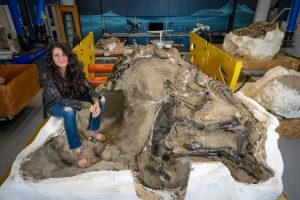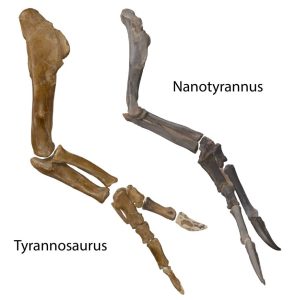Dueling Dinosaurs Fossil Forces Major Rethink of T. Rex Evolution
A groundbreaking study reveals that the famous “dueling dinosaurs” fossil actually features a fully grown Nanotyrannus rather than a juvenile T. rex, overturning decades of paleontological research.
Key Takeaways
- The “dueling dinosaurs” fossil contains a mature Nanotyrannus, not a young T. rex
- Nanotyrannus was a separate species: 18 feet long, agile, with larger arms than T. rex
- Decades of T. rex research may need reevaluation due to misidentified fossils
- The discovery identifies a second Nanotyrannus species called Nanotyrannus lethaeus
Mistaken Identity Uncovered
After five years of intensive research, scientists have determined that the smaller dinosaur in the legendary “dueling dinosaurs” fossil is actually a fully grown Nanotyrannus lancensis, not a juvenile Tyrannosaurus rex as previously believed.
“We have the growth record preserved in the microstructure of the bone, which shows that it’s an adult,” said James Napoli, coauthor of the study published in Nature. This discovery forces a reconsideration of many fossils previously identified as teenage T. rex remains.
Two Distinct Predators
Despite similar appearances, Nanotyrannus and T. rex were dramatically different dinosaurs. Nanotyrannus measured 18 feet long, was built for speed with long legs and strong grasping arms, while the 42-foot T. rex relied on brute strength and a devastating bite.
“Bones don’t shrink when animals grow so this could not have possibly become an adult T. rex,” Napoli explained, noting that Nanotyrannus had larger upper limbs than even fully grown T. rexes.
Research Implications
The finding “flips decades of T. rex research on its head,” according to coauthor Lindsay Zanno. “A wealth of studies on the biology of T. rex over the past three decades have unknowingly mixed data from Nanotyrannus with that of T. rex.”
The research examined over 200 Tyrannosaur fossils, revealing that juvenile T. rex fossils are less common than previously thought, with many actually being Nanotyrannus specimens.
Scientific Consensus Challenged
The study raises “uncomfortable” questions about why scientific consensus formed so quickly around the idea that all Nanotyrannus specimens were juvenile T. rexes, noted Larry Witmer of Ohio University, who wasn’t involved in the research.
“There is much more at stake here than declaring a victor in the debate,” Witmer said. “There are literally decades of research and probably hundreds of publications based on a premise that this article overturns.”
New Species Identified
Researchers also identified fossil “Jane” as a second Nanotyrannus species, naming it Nanotyrannus lethaeus after the River Lethe in Greek mythology, reflecting how this dinosaur remained “forgotten” for decades.
Expert Reactions
Steve Brusatte of the University of Edinburgh admitted the new evidence shows he was “wrong — at least in part” about considering smaller skeletons as juvenile T. rexes. He called for “a fundamental reassessment of tyrannosaur classification and evolution.”
Thomas Carr of the Dinosaur Discovery Museum called the evidence “pretty conclusive” but urged caution about reclassifying all specimens, noting the challenge of distinguishing between adult Nanotyrannus and teenage T. rex due to their similar size and features.
Future Research
The dueling dinosaurs fossil, discovered in 2006 in Montana’s Hell Creek Formation, remains partially encased in rock with many secrets still to uncover. The Nanotyrannus specimen is exceptionally rare at 100% complete.
Scientists hope to find preserved skin or feathers in the surrounding sediment and explore potential injuries on the specimen. “There is a tremendous amount of science to do on the dueling dinosaurs,” Napoli said. “It’s an amazing fossil to work on.”








